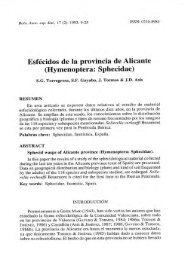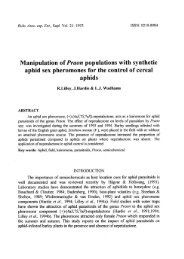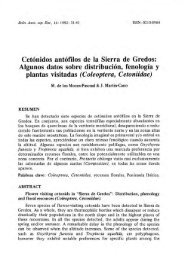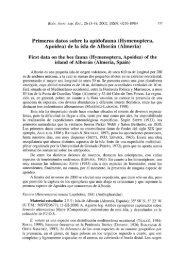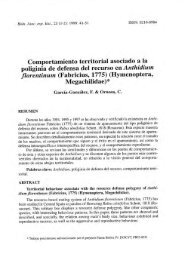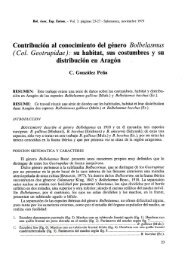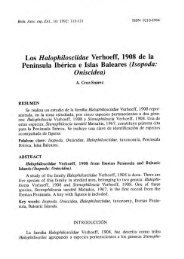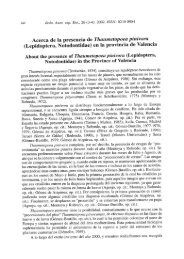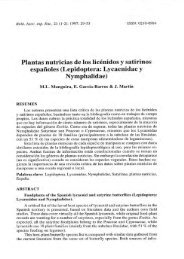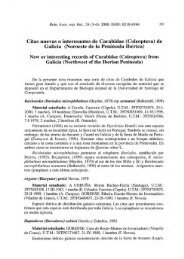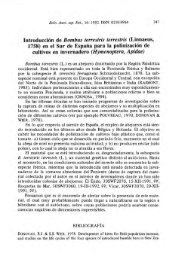Libro 1.indb
Libro 1.indb
Libro 1.indb
You also want an ePaper? Increase the reach of your titles
YUMPU automatically turns print PDFs into web optimized ePapers that Google loves.
GALL MIDGES (DIPTERA: CECIDOMYIIDAE) OF THE IBERIAN PENINSULA 105<br />
Dasineura andrieuxi (Tavares, 1902)<br />
Larvae change into galls terminal or axial buds on stem of Halimium calycinum (L.) K. Koch<br />
(= H. commutatum Pau, = H. libanotis (L.) Lge) (Cistaceae). Occurrence: scarce (Fig. 33).<br />
References: TAVARES (1902c, 1905a). Distribution: Mediterranean.<br />
Dasineura aparines (Kieffer, 1889)<br />
Larvae cause large galls on the growing tips of Galium aparine L. (Rubiaceae). Occurrence:<br />
very scarce (Fig. 34); Matadepera (Barcelona, 1990) leg. Pujade-Villar. Reference:<br />
SKUHRAVÁ et al. (1996). Distribution: European.<br />
Dasineura asparagi (Tavares, 1902)<br />
Perrisia asparagi Tavares, 1902<br />
Larvae cause galls at tips of young branches of Asparagus aphyllus L. (Liliaceae). The<br />
thorns remain small, are swollen and adpressed to swollen shortened stem. Under the deformed<br />
thorns one white larva develops. Occurrence: medium frequent (Fig. 34). References:<br />
TAVARES (1902b, 1905a, 1919), COGOLLUDO (1921). Distribution: Mediterranean, endemic<br />
to the Iberian Peninsula.<br />
Dasineura asperulae (F. Löw, 1875)<br />
Larvae cause rounded whitish spongy swellings on stems of Asperula cynanchica L. and A.<br />
cynanchica ssp. aristata L. (Rubiaceae). Occurrence: scarce (Fig. 35). References: TAVARES<br />
(1902a, 1905a), VILARRÚBIA (1936), BELLIDO et al. (2003). Distribution: European.<br />
Dasineura axillaris (Kieffer, 1896)<br />
Red larvae cause axillary bud galls on stems of Trifolium medium L. (Fabaceae).<br />
Occurrence: very scarce (Fig. 32). Reference: SKUHRAVÁ et al. (2002), BELLIDO et al.<br />
(2003). Distribution: European.<br />
Dasineura bragancae (Tavares, 1904)<br />
Larvae cause large leaf galls on Thalictrum flavum (L.) (= T. glaucum Desf.) (Ranunculaceae).<br />
The gall of the size of a plum is formed of many small deformed leaves, inside with many<br />
larvae which pupate there in white cocoons. Occurrence: very scarce (Fig. 35). References:<br />
TAVARES (1904a, 1905a). Distribution: Mediterranean, endemic to the Iberian Peninsula.<br />
Dasineura broteri (Tavares, 1902)<br />
Larvae cause oval or cone-shaped galls on Erica ciliaris L. (Ericaceae). The gall is formed<br />
of many scale-shaped leaves and is similar to the gall of Dasineura ericaescopariae. Occurrence:<br />
medium frequent (Fig. 36). References: TAVARES (1902a, 1905a, 1909, 1919),<br />
HOUARD (1918), COGOLLUDO (1921). Distribution: Mediterranean.<br />
Dasineura brunellae (Kieffer, 1909)<br />
Perrisia brunellae Kieffer, 1909<br />
Red larvae live between two erected leaves at the vegetative tip of Prunella vulgaris L.<br />
(Lamiaceae). Occurrence: very scarce (Fig. 36). Reference: TAVARES (1920). Distribution:<br />
European.<br />
Dasineura capsulae (Kieffer, 1901)<br />
Larvae produce hard galls on the growing points of Euphorbia cyparissias L. and E. nicaeen-<br />
Boln. Asoc. esp. Ent., 30 (1-2): 93-159, 2006



